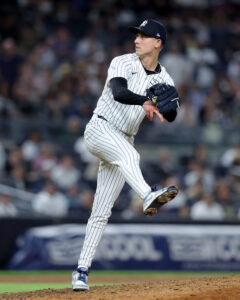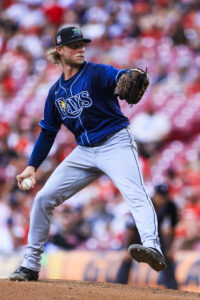After an injury-ruined 2025 season, veteran right-hander Zach Eflin is back with the Orioles on a one-year deal. The 31-year-old (32 in April) underwent a lumbar microdiscectomy procedure in August. At the time, he and the team indicated that while the procedure can come with a recovery timetable of four to eight months, he was hopeful that he’d be able to have a normal offseason after roughly 12 weeks of recovery.
There hasn’t been much concrete information about his rehab window since that time, but on a Zoom call with the Orioles beat, Eflin revealed that he’s slated to throw his first bullpen session on Jan. 6 (via the Baltimore Sun’s Matt Weyrich). Eflin added that his goal is to be ready for Opening Day, though he noted that timetable is still very much subject to change. Obviously, his ultimate return point will hinge on how his ramp-up period goes now that he’s been cleared for his first post-op bullpen session.
A healthy Eflin would, at least on paper, give the Orioles a full rotation. He’d slot in alongside Trevor Rogers, Kyle Bradish, Dean Kremer and newly acquired Shane Baz. That’s a solid group if everyone’s healthy, but that’s a colossal “if.” Eflin pitched just 81 1/3 innings last year before that season-ending back surgery. Bradish pitched only 54 innings between the minors and the big leagues as he returned from Tommy John surgery. Baz tossed a career-high 166 1/3 innings but totaled only 106 1/3 major league frames across the three preceding seasons, due primarily to Tommy John surgery. Depth options like Cade Povich, Chayce McDermott and Brandon Young give the O’s some cover, but none of that trio has established himself in the big leagues just yet.
The Orioles have been connected to a wide swath of notable starters via both trade and free agency. Their pursuit of Miami righty Edward Cabrera has reportedly cooled, but Baltimore has been linked to free agents like Tatsuya Imai, Ranger Suarez and Framber Valdez throughout the offseason. Bringing Eflin back at a pretty reasonable rate shouldn’t stand as a major impediment to any subsequent additions. RosterResource projects Baltimore’s payroll for about $147MM as of this writing. That’s $13MM shy of their 2025 mark. It stands to reason that ownership is willing to at the very least replicate that level of spending, if not push the payroll further north.
Virtually no team makes it through a full season in today’s game with only five starting pitchers. The Orioles are even likelier to need extra arms than most. Bradish and Eflin will see their workloads managed to varying extents. Rogers and Baz have notable injury histories. Whether in spring training or throughout the marathon regular season, the Orioles are sure to incur injuries on their staff. They had eight pitchers start six or more games for them in 2025, and that includes free agent Tomoyuki Sugano, who started a team-high 30 games. They’ll likely have at least seven or eight pitchers with 10 or more games started.



